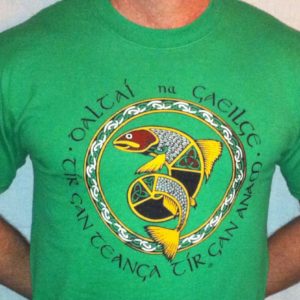Forum Replies Created
-
AuthorPosts
-
LiamO
ParticipantRead the following page carefully, especially the last paragraph:
http://www.nualeargais.ie/gnag/person.htm
Basically, it shows emphasis. Imagine a child boasting about going to a party that her brother wasn’t allowed to attend. James isn’t going, but I am. In English, she’d put emphasis on the word I. She’d say “I” louder and with more emphasis because she’s boasting.
In Irish, the same would be rendered instead with the suffix -se.
Níl Séamus ag dul ann, ach táimse.
There’s no need to say the new word (táimse) with extra emphasis as in English, the suffix itself does the job in Irish.
LiamO
ParticipantIn Connacht, féachann sé lena dhéanamh would be a valid way of saying it. See:
https://www.teanglann.ie/en/fgb/féach_leLiamO
ParticipantDoes anyone have any good links to explain the prounciation of ‘f’ in the past habitual, as well as the future and conditional autonomous. This has long puzzled me. For example:
thiocfainn
thiocfá
thiocfadh sé/sí/sibh
thiocfaimis
thiocfaidístiocfar
thiocfaíIs the f always pronounced as [h] in these?
In Erris the ‘f’ in future and conditional forms are realised as a /h/ sound, including autonomous and second person singular forms. This /h/ is often the only thing differentiating the conditional and past hab. form of a verb, though some irregular verbs (as you’ve cited here) change their stems:
Thiocfainn > Thiginn
November 1, 2013 at 10:04 pm in reply to: New database of spoken native Breton — might be a good model to follow #44785LiamO
ParticipantGRMA 🙂
November 1, 2013 at 9:21 pm in reply to: New database of spoken native Breton — might be a good model to follow #44782LiamO
ParticipantGRMA. An bhfuil aon mhaith sa gcúrsa Assimil?
November 1, 2013 at 1:49 am in reply to: New database of spoken native Breton — might be a good model to follow #44777LiamO
ParticipantGo raibh maith agat, is ádh mór leis an bpróiseacht!
Tá ceist amháin agam dhuit; dar leat céard iad na leabhair 7rl. is fearr ar an margadh inniu leis an mBriotáinis a fhoghlaim?
LiamO
ParticipantBooks books books. Start to invest in quality children’s literature and read with them often. I doesn’t have to be a formal lesson, just reading with the two of them. When they become familiar with the story you can base activities around it. Use sticky notes to block out words (works well with big books) and have them guess the word as it comes up in the story. Pick out details from the picture and ask questions about it e.g. cén dath atá ar hata Liam? srl. You’ll also notice that children’s books repeat the same sentences over and over again, get them involved in the reading of the story by drawing on these. As familiarity increases they’ll be able to recite much from memory. As time goes on, why not role play the stories. It will be basic, but is fun and gives purpose to the words. Songs are also great in this respect. Hope it helps!
Here’s a good source for books: http://www.litriocht.com/shop/index.php?cPath=59_60
LiamO
ParticipantThe verb Tig + le is also used in much of Connacht (Acaill, Tuar Mhic Éadaigh, Iorras). Táim “in ann” is another Connacht form, not sure if it’s found elsewhere? Tobar na Gaedhilge returned no results for Munster or Ulster. One that I often hear (more so in the Ulster dialects) is “Táim ábalta”.
LiamO
ParticipantA Ruairí, cá bhfuil conaí ort féin?
Mír de Ghaeilge (nó Gaeilg) Bhaile Chruaich le cluinsint anseo, má atá suim agaibh ann:
LiamO
Participant/ba:X’u/ i Maigh Eo fost’.
An t-ainmfhocal “Báthadh”- /ba:hu:/
(Brón orm faoi na siombailí thuas).
LiamO
ParticipantBíonn tinte againn chomh maith anseo in Iorras, ach nach ar an 23 a cheiliúrtar oiche fheil’ Eoin?
LiamO
ParticipantThanks to all for the clearing that up.
LiamO
ParticipantAh, very interesting! Where I come from the notion that up is south and vice versa is still often used in english. If you look at the map on this page: http://www.interhabs.ie/development
If standing in Beal an Mhuirthead, centre, we say “I’m going up to Gaoth Saile or Doohama, going down to Rossport or Carrowtige, out to Glencastle, back to Each Léim, and for some strange reason, “abroad to Bangor”. I suppose its widespread in Ireland.
LiamO
ParticipantThanks so much! I spent the day listening to Padraig Ó Gionnáin and Padraic Ó Murchú, now I have all this to go through! I recognise a few faces in that video, I must get onto them with this footage.
LiamO
ParticipantTá an leagan “Ní Rinne” ( Ní Rinní i gCondae Mhaigh Eo) cloiste agam in agallamh a rinne cainteoir dúchais as Inis Gé, meas sibh an botún a bhí ann, nó leagan canúnach?
Deirtear “In éis” comh maith in áit tar éis/in dhiaidh…..meascán eatarthu is dóigh liom!
-
AuthorPosts
